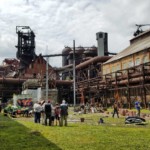Prioritizing equity in local climate action: An equity framework from industrial legacy cities
In the past years, citizen-led activism around the Fridays for Future movement and other climate justice groups have succeeded to make themselves heard, generate political momentum and mainstream climate change awareness across the broader population.
Some local governments have answered these calls for action by declaring climate emergency in their cities and towns, often paired with commitments to assess climate relevance across all their decisions and policies.
At the same time, decision-makers have been faced with growing resistance when failing to address the social consequences of new environmental legislation and climate policies, one prominent example being the yellow vest movement in France. When setting the course towards a low-carbon future, how can we ensure that our policies leave no one behind? How can climate interventions be planned with social equity in mind?
Transition challenges: Why industrial legacy cities have learned to consider equity

It is worth taking a close look at a group of cities that have been dealing with urban transitions for decades. Industrial legacy cities – those whose local economy developed around fossil-fuel-based industries and heavy manufacturing – have seen extensive environmental pollution from their signature industries.
The impacts have been particularly strong in areas close to the mines and factories, where workers traditionally lived. With the industrial decline, these cities’ large working populations suffered the most, from severe job loss to neighborhood disinvestment. Early structural change programs have often failed to create a real perspective for these groups.
Subsequently, many industrial legacy cities recognize social inequalities among their most pressing transition challenges. They have created programs that focus on social inclusion and opportunities for historically underprivileged groups.
One example is the “nordwärts” program in the former steel and coal city of Dortmund, Germany, aims to improve the quality of life in all parts of the city with a specific focus on former mining quarters in the north. Through participatory processes, more than 200 projects have been established to co-create livable environments, strengthen local communities and attract new investment for low-income neighborhoods.
Across the Atlantic, industrial legacy cities Baltimore and Cincinnati have adopted targeted universalism strategies to address historic inequalities. Developing their local sustainability plans based on equity frameworks, they ensure all residents participate in and benefit from public programs and marginalized groups find the support they need. And Beijing E-Town, China is seeking to generate new local jobs and foster opportunities through collaboration with businesses and research institutions under their zero waste strategy.
In all those cases, the first step towards an inclusive transition is recognition for groups that have been left behind and a commitment to achieve healthy and just conditions for all local residents. From the forward-looking, equity-focused programs in industrial legacy cities, we can draw valuable learnings and practical tools for making change happen.
In practice: How to design interventions with an equity lens
In practice, implementation requires a common and tangible understanding of social equity among all stakeholders. From the various projects and programs industrial legacy cities have shared under the Urban Transitions Alliance initiative, the Alliance Secretariat has developed an equity framework based on three simple dimensions:

ACCESS
How can programs support equal access to public services and infrastructures for all local residents – independent of factors like age, neighborhood, income, social group or language?

PARTICIPATION
The more programs are designed with residents (rather than for residents, including all voices across the city and involving those affected early-on, the more they meet local needs and generate long-term impacts.

OPPORTUNITY
To offer fair perspectives for all, how can interventions provide 1) improved access to quality education for all, 2) provision of career perspectives and 3) increased diversity in employment?
These dimensions help to communicate about social equity, spur equity thinking, and can be used to assess and incorporate positive equity outcomes in sustainability projects. They are by no means mutually exclusive – very often, programs succeed best when all three aspects are considered early on. This can be seen in Turku, Finland, where social equity is a key pillar in the planning of circular economy interventions to achieve the city’s 2029 carbon neutrality goal. The three equity dimensions are mapped across the five priority sectors of the Circular Turku project, identifying approaches to strengthen “access”, “participation” and “opportunity” outcomes.
SEE THE URBAN TRANSITIONS ALLIANCE EQUITY FRAMEWORK
Learn more about the social equity work in industrial legacy cities with these session recordings from Daring Cities 2020, the global virtual forum for urban leaders boldly tackling the climate emergency, especially in light of COVID-19. Urban Transitions Alliance cities shared their inclusive transition stories and showcase how they are addressing their climate and inequality challenges hand in hand.
 Prioritizing equity in local climate action
Prioritizing equity in local climate action
From planning to financing to implementation, industrial legacy cities Buffalo, Pittsburgh, Turku and Glasgow show in practice how they are incorporating a social equity focus into their ambitious sustainability work.
 Bold Circular Development as Daring Climate Action
Bold Circular Development as Daring Climate Action
As industrial legacy cities are exploring strategies to transform into a low-carbon society, the city of Essen is adopting circular economy principles to accelerate its transition from grey to green.

Embedding Climate Neutrality Ambition Throughout Sustainable Development
How can cities succeed to achieve their ambitious climate targets? Among other local leaders from around the world, Mayor William Peduto highlights how Pittsburgh has learned from the past to emphasize inclusive and equitable planning and policy-making.
This piece originally appeared on the Urban Transition Alliance website.







